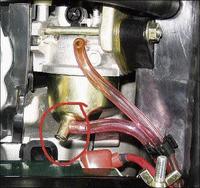Paul Messam, Gleaner writer
Let's deal with the facts. If a motorist was to pour gasolene straight into the engine without the proper mixture of air, the engine would fail to start. "Even a suitable mixture of gasolene and air must be controlled or the engine would be quite difficult to manage," says Ameir Johnson, auto mechanic. According to Johnson, the real function of the carburettor could be aptly described as a very complex arrangement of needles and seats, high- and low-speed jets, adjusting screws, pumps, diaphragms, air passages, springs, check valves, vacuum-operated devices and other elements.
But where is the carburettor? The base of the carburettor is mounted to the top of the intake manifold. Attached to the top throat of the carburettor is a filter that cleans the large volume of outside air that is drawn down through the inside bore of the carburettor.
vary significantly
It must be noted that carburettors vary significantly in make, and the adjustments they require. Generally speaking, some of the adjustments that can be made are 'slow idling speed, also known as curb-idling speed and hot-idling speed; fast-idling speed, also called cold-idling speed; idle mixture; and, dashpot.
It must be noted that manufacturers set various conditions for setting slow-idling speed. Some require that it be set with the transmission in gear. Others want it set with the transmission in neutral. The information label and service manual will also specify slow-idling speed.
Adjusting slow-idling speed
1: Simply begin by warming up the engine.
2: Connect a tachometer. Remember to leave the engine running.
3: Find the slow-idling-speed-adjusting screw. This screw is located at the throttle shaft, resting against a flange on the shaft. Turn the screw. It causes the throttle valve in the carburettor to open or close, thus changing the idling speed.
4: Adjust the slow-idling-speed screw to move the idle-stop solenoid, if the carburettor has one, back and forth on its bracket, or turn a rut on the end of the solenoid bracket. On some vehicles, idling speed is set by disconnecting the solenoid wire and using an adjusting screw. Reconnect the solenoid wire and adjust slow-idling speed with the carburettor air cleaner in place.
Adjusting fast-idling speed
One should check the emissions information label or service manual for specified fast-idling speed and conditions, if any, under which the adjustment is made. Adjust this speed as follows:
1. Connect the tachometer.
2. Remove the air-cleaner housing from the carburettor.
3. Pull back the throttle linkage and close the choke plate. Position the fast-idling speed screw against the particular step of the cold-idle cam specified in service instructions. This step may be marked with an identifying mark, (<).
4. Turn the fast-idling-speed adjustment screw, until the tachometer records the specified fast-idling speed.

